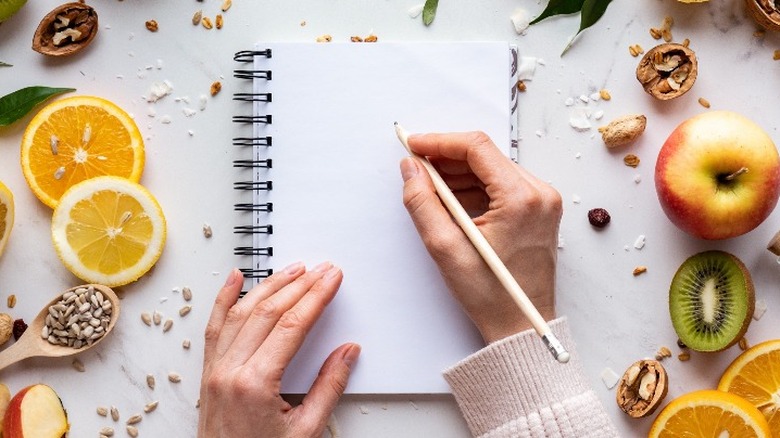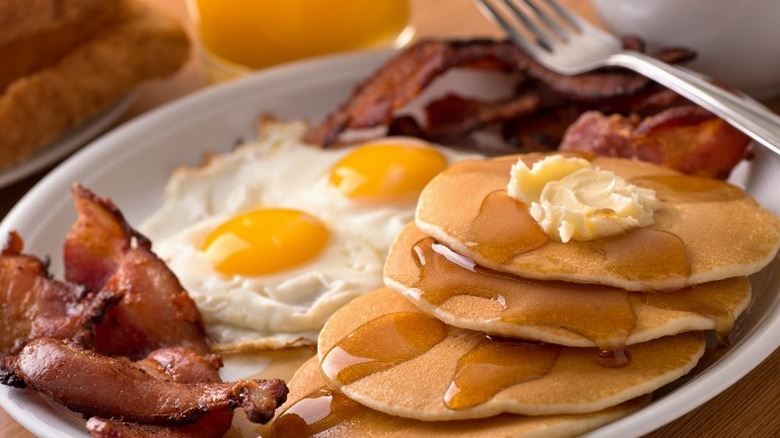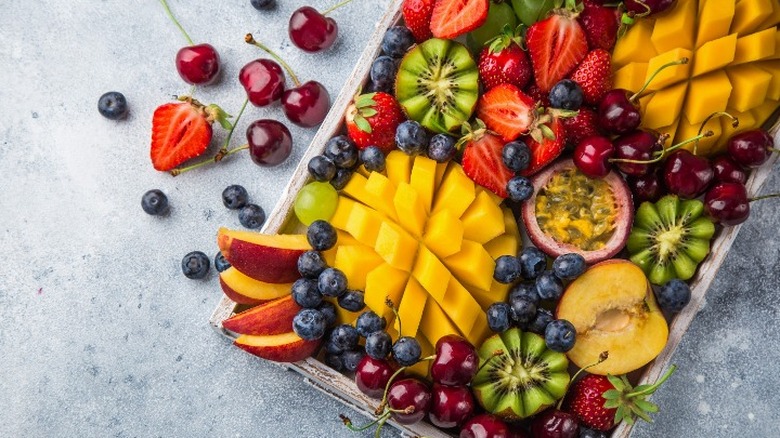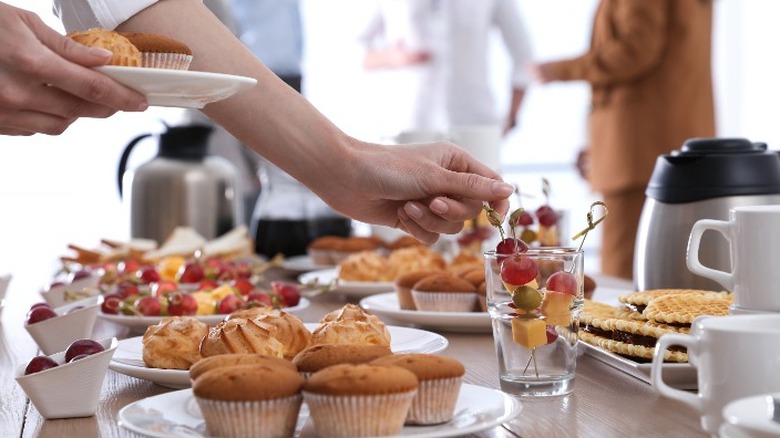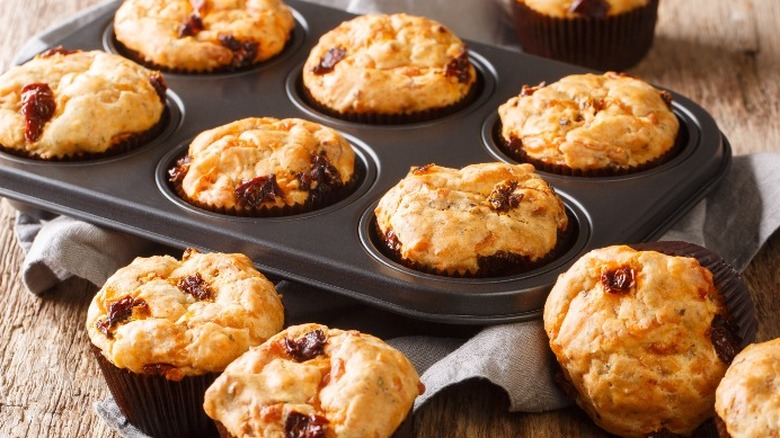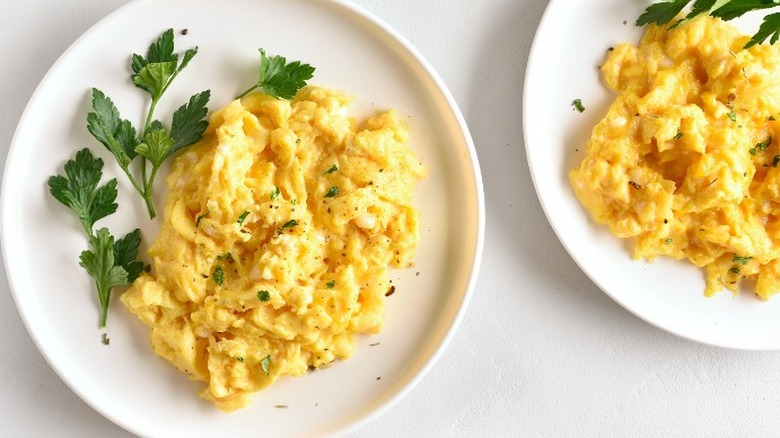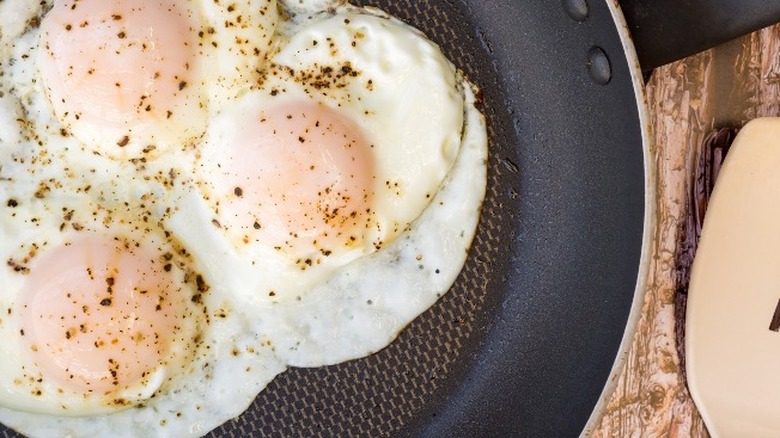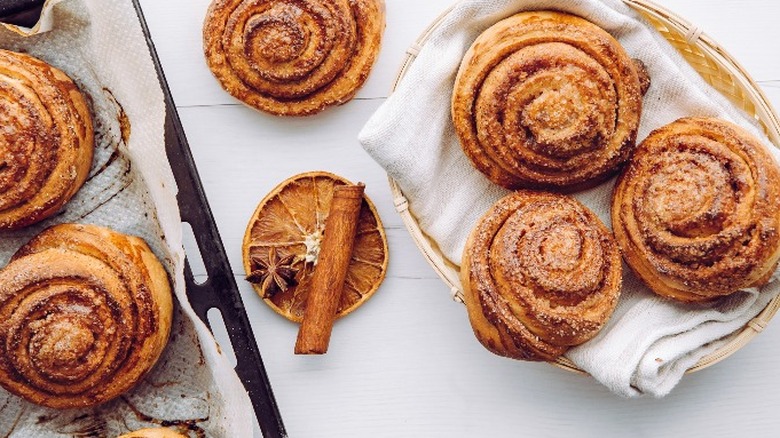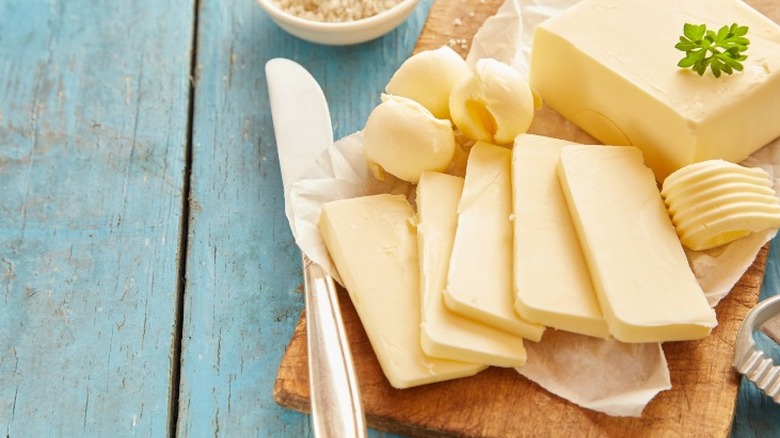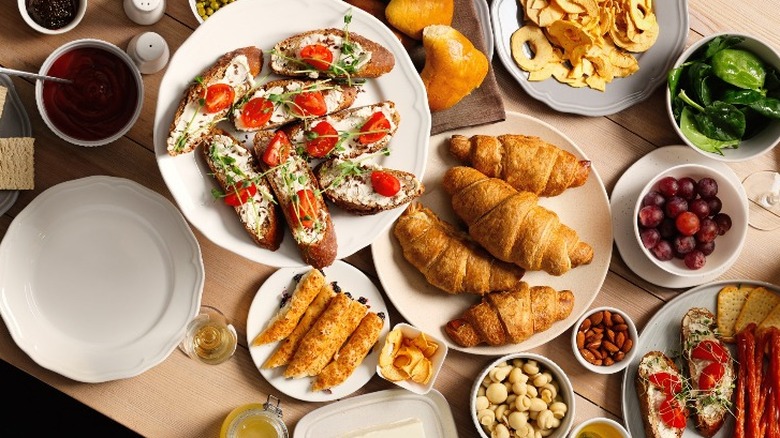The 13 Best Cooking Tips When Making Brunch
Who doesn't love a good brunch? It's the perfect excuse to sleep a little and work your way into a late-morning plate of all the sweet and savory selections your heart desires. But when you're the person in charge of hosting brunch, things aren't quite as relaxing.
The host wears more than a few hats. You're the friendly greeter at the door, the home chef, and the housemaid that cleans up after everyone leaves. There are endless platters of food to prepare, coffee to be brewed, and friends to entertain. However, if you're equipped with tried-and-true cooking tips, your day should run more smoothly.
You'll want to start by making a plan and sticking to it. By designing a practical menu based on your guests and preparing most of your day in advance, you will set yourself up for success. You can do plenty more, like serving food in a buffet line and preparing drink stations outside your workspace.
While your brunch is all about your guests, you should have a chance to enjoy yourself as well. Luckily, we've hosted several meals and learned a thing or two over the years.
Plan your menu according to guests
Unlike other gatherings, brunch is often an intimate event for close friends and family. Since you probably know most people attending your mini banquet, it's considerate for you to know about dietary restrictions, allergies, and other food-related considerations.
Nothing will make a vegan friend or relative feel more loved than to know you thought about them when preparing a special vegan breakfast tacos platter. Not only did you take the time to learn about their eating style, but you cooked something delicious that they and others can enjoy. Even if you aren't 100% sure about everyone's eating habits, serve at least a few plant-based options to be safe.
Aside from eating styles, food sensitivities, intolerances, and allergies are always essential to consider when serving brunch to guests. Shellfish is the most common food allergy in adults, so keep that in mind if you plan on prepping shrimp, scallops, or oysters for your fancy feast.
A safe route is to ask guests about any food allergies they may have upon invitation and build your menu based on that. Even if only one guest has a common peanut allergy, it's worth knowing about it ahead of time, so you can skip making that famous salted peanut butter bar recipe for dessert.
Offer sweet and savory options
Offering foods based on your guest's dietary restrictions is one way to have plenty of delicious (and safe) options, but providing sweet and savory choices is another excellent way to balance your brunch. When someone shows up to a brunch, they likely aren't expecting a plate of scrambled eggs with toast — they can make that at home, in the comfort of their sweatpants.
Your guests will probably expect a plethora of foods they can pile on their plates. That means offering savory dishes like this crustless spinach quiche recipe or a slow cooker breakfast casserole. It also means serving unique renditions of sweet breakfast foods everyone will love, like eggnog French toast casserole.
The real reason salt and sweets go together so well has everything to do with science. The pair satisfies our biological cravings, which helps our brains need exciting flavors. Adding fun foods that are both sweet and salty will surely take care of their cravings and taste buds. Even if you keep things simple with a platter of sausage and bacon to accompany eggs, along with a platter of little pancakes and waffles, your guest will leave feeling satisfied.
Always offer a fruit platter
Adding some form of a fruit platter is one excellent way to provide a sweet option for your guests. Whether you make a big fruit salad or a lovely sliced fruit arrangement, providing fresh fruit for your guests is essential for a quality brunch.
Your health conscience guests will love seeing a spread of fruit at the table alongside the heaping piles of home fries and bacon. Plus, any vegan or vegetarian guest will appreciate additional options for their restrictive diet. Fresh fruit can be a fantastic palate cleanser too. The acids in the juice will help remove food residues after a big meal or in between bites of different foods.
Offering fruit does something special for presentation as well. The vibrant hues of fresh berries, melons, and citrus fruits will look gorgeous amongst the beige and brown colors you see in sausage, potatoes, and toast. One way to help balance the appearance of your dishes is by adding two fruit options and spacing them out.
Make one big fruit salad and split the batch by serving it in two separate bowls or offer a bowl of fresh berries on one end and a platter of sliced citrus fruit on the opposite end.
Serve buffet style
If you plan on having a small group of three to five people in your home for brunch, an intimate family-style breakfast arranged at a table could be a great option. However, if you plan to have a large group of folks for a late morning brunch, your safest bet is organizing a buffet line for them.
A buffet is great for larger gatherings, especially if you host more than five to seven people. It allows your guests to grab food at their own pace while freeing your hands up for other important tasks, like cleaning up, catching up on dishes, and keeping your coffee station stocked.
Make sure you know ahead of time where you plan to lay out your buffet. The spread should be organized in a location that allows a line of people to walk smoothly through without interrupting the flow. Place all of your serving utensils out and ready to go, and don't forget to arrange plates and cutlery at the head of the table so guests can start with the essentials. Begin with savory hot foods, then end with sweet stuff, and remember to space your fruit out to allow for a balance of color.
Prep as much as possible ahead of time
If you want a chance to relax and enjoy time with family and friends, it's essential to prep most of your food ahead of time. That means only saving a few recipes to make the morning of and making most other dishes a day or two in advance. Foods that freeze well, like bite-sized cookies, muffins, and scones, can be made in advance if you need the extra time.
Prepping ahead also means digging through your pantry and cabinets to fish out crockpots, serving platters, and serving utensils the day before to ensure you're not looking for them in the craze of your busy morning.
Writing to-do lists is one excellent way to stay on track. Start by writing your entire menu, then a separate list that covers all the serving platters and utensils you'll need to serve. That way, you'll know before the big day whether or not you have enough trays and utensils for all your delicious food. Use the prewritten menu to check off the dishes you have already made so you know what you still need to prepare before guests arrive. You'll appreciate being organized on such a busy morning.
Make these dishes in advance
Luckily, there are lots of foods you can get away with making before the day of your brunch. Taking time a few days before guests arrive to cook certain foods will save you loads of stress the morning of.
No-kneading quick bread recipes or muffins pair beautifully with breakfast spreads and can be baked in advance because they keep well if sealed and stored in the fridge. Strudels, scones, and biscuits should also be made a day or so in advance to avoid using the oven the morning of your brunch. You'll want to save that hot box for breakfast casseroles and other savory dishes that need to be baked.
You can also prep a parfait station a day in advance. Get all the little bowls you need, fill them with choice toppings, and seal them with plastic wrap. Place each bowl over a quarter sheet pan and keep everything cold in the fridge until morning.
Crepe batters can be made the day before without any issues; however, you'll want to avoid making pancake and waffle batter too far in advance. When leavening agents are used in batters, the longer they sit, the less effective they will become over time.
Make these foods the morning of your brunch
You can prepare plenty of delicious foods a day or two before your brunch, but some dishes should never be made in advance. To ensure quality flavor and texture, you'll appreciate saving these dishes for the morning of your meal.
You might already know that eggs don't do well when boxed up and reheated. If there is one thing you want to get right on brunch day, it's eggs, so do not make them in advance. Most breakfast meats like bacon, sausage, and ham are pretty simple to prepare and will always taste best when heated and served that morning.
Any bread you plan to crisp and then butter up should be toasted to order rather than made in advance. This includes bagels, English muffins, and any other form of toast. You can prep these in advance by arranging them on a platter and then sealing them up with some plastic wrap, but obviously, don't brown anything until right before you serve.
If you plan to make a fancy dish, like a classic eggs benedict recipe (which is very popular for brunch), you'll need the make those dishes right before serving each guest. If you have many people coming, save yourself the hassle and aim for a less involved meal. Sometimes, keeping things simple is best for everyone.
Cook your eggs the right way
We can't stress enough how vital eggs are at brunch. You won't get away with having a tasty spread without at least one or two forms of this delicious protein, so if you're going to serve them, consider the best ways to do so.
Cooking your eggs too early is one of the biggest mistakes people make with eggs. Making them a day in advance and reheating them is perfectly safe if done correctly; however, the texture and flavor change dramatically. Avoid serving your guests rubbery, dry, overcooked eggs, and simply cook them before or as they arrive.
There are plenty of tips you need when cooking eggs, but some stand out amongst the rest. Be sure you use gentle, low heat when cooking eggs to avoid burning them, and use plenty of butter; choosing this fat over oil will reduce sticking and enhance flavor.
If you plan on making a big batch of scrambles, crack all your eggs in a separate bowl to catch bits of shells ahead of time and whisk them in your bowl before adding them to the pan. A large whisk will help incorporate air into your eggs and, in turn, give you those light and fluffy eggs you fancy. Finally, whatever you do, don't overcook your eggs.
Set up a coffee station
Possibly one of the best things you can do for yourself during brunch is to set up a fancy little coffee station for your guests to run to when they need their morning cup of joe. More importantly, make sure to set that station up outside of the kitchen.
If you've ever had a crowd of hungry mouths in your home, you likely know the pain of everyone migrating into the kitchen. While you, too, want to catch up and talk with friends, there's usually too much to be done and not enough room to dance around everyone in the kitchen.
If you set up your coffee station in a separate room, you'll give your guests more reason to stay the heck out of your work area. Follow this nifty TikTok hack by setting up a station with a coffee or espresso machine (if you have one) and all the fancy syrups your guests will need to make something delicious.
Consider also adding hot cocoa options for kids, along with pretty coffee mugs, spoons, and all the essentials needed to brew a delicious hot drink they will love to sip on.
Offer a variety of beverages
A small coffee cart is one way to keep your friends and family out of the kitchen, but an entire bar area designated for making cocktails and spritzers will also help. This is excellent if you plan on serving fun morning cocktails and spritzers.
Before selecting standard drinks like bloody Marys and screwdrivers, think outside the box. First, consider the season, weather, and time of year. In the fall and winter, find delicious cocktail recipes that celebrate apples, cranberries, and warming spices. Spiked ciders, mulled wines, and brandy milk punch recipes will taste lovely during those cold months. In the spring and summer, choose in-season berries and fruity juices made with pineapple and passionfruit. Luckily there are loads of delicious brunch cocktail ideas and spritz recipes available.
If you are new to making cocktails, try taking simple recipes you already know, like a screwdriver, and spruce it up. Instead of just vodka and orange juice, add a splash of pineapple or a homemade strawberry coulis for color and flavor. Don't forget to add a strawberry and a pineapple wedge garnish before serving. Otherwise, keep things simple by making one large brunch punch. You'll have a signature cocktail for folks to serve to themselves, and you can make it in advance.
Aside from all those boozy beverages, you should consider providing a few nonalcoholic drinks, too.
Don't forget to use your sheet pans
It might sound silly, but the sheet pan in your kitchen cupboards is one tool you will appreciate having on hand whenever you have guests over for brunch. While the humble sheet pan is best known for baking cookies and roasting veggies, you'll be surprised to see that it comes in handy for way more than cooking purposes.
The absolute best uses for sheet pans will come to light the day before and the morning of brunch. If you have a sturdy sheet pan, then be sure to use it as a tray when it's time to set the table a day in advance. Pile up those plates, mugs, and cutlery, and use your sheet pan as a transfer tray from the kitchen to the table. You can also use it to clean up around the house if people leave dishes and cups all around.
Otherwise, use it as a decorative snack board or serving platter. It's the perfect tray for holding sliced bread, bagels, and biscuits, but also a great way to present your fresh baked muffins, scones, and sliced quick bread.
Spruce up your butters and spreads
If you aren't exactly fond of making fancy dishes, there are subtle ways to spruce up your feast without going above and beyond. Something as simple as flavored butter or cream cheese will excite your guests.
If you plan on serving a platter of bread, bagels, and croissants, you can easily take the flavor up with tasty, unique kinds of butter and other spreads. Sweet compound butter with infused flavors will give your guests something special to savor in each bite. You can even try your hand at making a butter board which is a sure way to elevate the appearance of your table. A butter board is a wood board with large slathered gobs of butter across the surface, topped with herbs, fruits, and other fun toppings. Serve that with fancy rustic toast, and your entire brunch earns a few extra stars!
Consider making a simple cinnamon sugar butter or an everything cream cheese spread for a less extravagant approach. Although they are quick and easy to make, your guests will still be impressed and enjoy every bite.
Check temperatures and don't leave food out
Entertaining guests while keeping track of all your food can be a lot of work, but there are a few mistakes you don't want to make, and they have everything to do with food safety. More likely than not, your guests will stay for at least a few hours, but that doesn't mean you can safely keep these brunch foods on the counter for that long.
Slow cookers and chafing dishes are great for keeping your food hot, but the only way to know they are safe is by temping them and ensuring that foods stay out of the danger zone. The danger zone, which is between 40 F and 140 F, is a zone where bacteria grow rapidly (per USDA).
Be sure to watch the clock once you bring food out. Any cooked foods left at room temperature for more than two hours should be discarded as they will end up in the danger zone and become dangerous to eat. The only thing worst than getting food poisoning is being the person who accidentally causes it.

